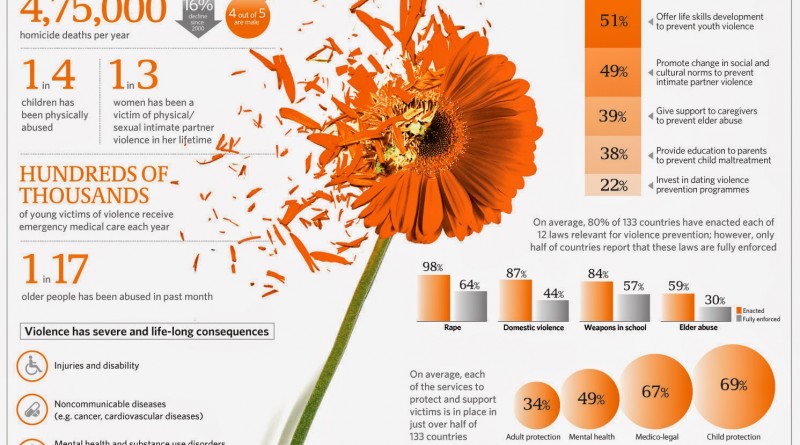UN: Homicide rates decreased by 16% globally between 2000 and 2012
The World Health Organization has jointly published with the United Nations Development Programme, and the United Nations Office on Drugs and Crime the first Global status report on violence prevention 2014. The report is a unique follow-up on the 2002 World Report on Violence and Health and offers data on the efforts to prevent killing and other forms of violence from 133 countries.
Although the report reveals that that 475,000 people were murdered in 2012, and homicide is the third leading cause of death globally for males aged 15-44 years, the fact that homicide rates decreased by 16% globally between 2000 and 2012 is a positive figure that supports the effectiveness of nonkilling action.
The Global Status Report is part of the efforts of the WHO Violence Prevention Alliance, of which the Center for Global Nonkilling is an active participant and a member of its research agenda priorities and academic collaborations work groups. This sustains the opening words of Margaret Chan, Director-General of the World Health Organization: “Yet we know what works to prevent violence in our homes, schools and workplaces and on our streets and playgrounds. We should take inspiration from governments which have demonstrated success in reducing violence by taking the steps needed. They have shown us that indeed violence is preventable.”
The Global status report on violence prevention 2014 calls for a scaling up of violence prevention programmes in all countries; stronger legislation and enforcement of laws relevant for violence prevention; strengthened justice and security institutions to uphold the rule of law; and enhanced services for victims of violence. It also advocates for better and more effective use of data to inform violence prevention programming and to measure progress. The report is intended for use by governments to help identify gaps and encourage and guide actions, and by nongovernmental organizations and experts to assist governments in their efforts.
The Global status report on violence prevention 2014 represents another important pillar en the building of solid data and evidence-based practices to prevent violence, with a particular focus on killing. Just recently, the United Nations Office on Drugs and Crime also published its Global Study on Homicide 2013, that clearly states: “The study of intentional homicide is relevant not only because it is the study of the ultimate crime, whose ripple effect goes far beyond the initial loss of human life, but because lethal violence can create a climate of fear and uncertainty. Intentional homicide also victimizes the family and community of the victim, who can be considered secondary victims, and when justice is not served, impunity can lead to further victimization in the form of the denial of the basic human right to justice.”




